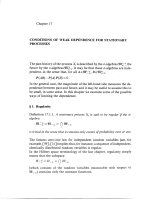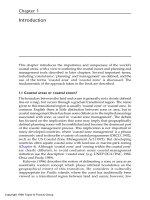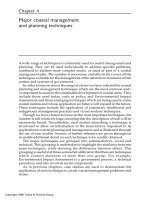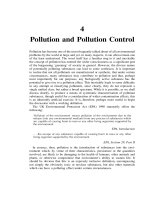Corporate Environmental Management - Chapter 17 ppt
Bạn đang xem bản rút gọn của tài liệu. Xem và tải ngay bản đầy đủ của tài liệu tại đây (481.79 KB, 8 trang )
167
Chapter 17
Global Warming
Global climate change is evolving. The regulation of greenhouse gas emis-
sions is still in the formative stage; the potential for firms new to the market
is high. Most companies are still on an evolving learning curve. Whereas
the United States has currently withdrawn from the Kyoto Protocol, the
issue of regulating CO
2
and other greenhouse gas (GHG) emissions as a
contributor to global climate change is not going away. The “Clean Skies
Initiative” does not regulate CO
2
, but numerous other pieces of legislation
that regulate CO
2
have been filed in Congress. Most notable of these is
Senator Jeffords’ “Clean Power Act” (S.556). The current national multi-
pollutant debate is over a “three-pollutant” (NO
x
, SO
x
, and Hg) versus a
“four-pollutant” (NO
x
, SO
x
, and Hg plus CO
2
) bill. The potential passage of
any bill at this point is unclear, but the issue will continue to be part of the
national debate. The question of regulating CO
2
is probably not an “if” but
a “when,” and by extension, “how.”
At the state level, many states have passed or are considering regula-
tions that address CO
2
or GHG emissions. Massachusetts has adopted the
first regulations in the country that cap CO
2
emissions and set emission
rate limits. New Hampshire is close to passing a regulation, and California
is in the process of setting up a greenhouse gas registry.
Internationally, the Kyoto Protocol is moving forward, even without U.S.
participation. At least 55 nations, accounting for 55% of the 1990 GHG emis-
sions, were needed to ratify Kyoto for it to enter into force. More than
55 nations have ratified Kyoto, but the percent of emissions represented
by these nations was below 55% by 2003. The European Union and Japan
both ratified Kyoto, and all eyes turned to Russia. Russia’s ratification
brought Kyoto into force even without U.S. participation. Because it brings
the percent of emissions above 55%, passage of Kyoto means that a large
multinational U.S. company doing business in a country that is a partici-
pant in the Kyoto Protocol—particularly an energy company—can expect
some form of regulation of GHG emissions.
There are still other national regulations being put into place. In Europe,
Denmark and the U.K. have emission-trading programs in place. Denmark
passed the CO
2
Quota Act in 1999. It places a mandatory cap on CO
2
emis-
sions from electricity producers. Participation in the U.K. program is
55461_C017.fm Page 167 Tuesday, June 5, 2007 11:06 AM
© 2008 by Taylor & Francis Group, LLC
168
CORPORATE ENVIRONMENTAL MANAGEMENT
voluntary (though encouraged by government tax incentives) and covers
all industries and all six Kyoto gases. In March 2002, the U.K. auctioned off
allowances that will be used in a trading program to help meet voluntary
emission reductions.
Compliance issues for companies currently differ and will continue to
differ from state-to-state and country-to-country. Hence, a large multi-
national company with facilities in different states and throughout the
world may have multiple regulatory issues that affect it. How those regu-
latory programs do or do not interact with each other is complex and will
require constant vigilance. This creates a high level of uncertainty and
thus a need for our services to—at a minimum—track these changes in
the regulatory arena.
Existing Market and Potential Revenue
Much of the early work on global climate change came from the realm of
“think tank” activity. These studies and white papers included initial demon-
stration projects and sample protocols for establishing baselines, emission
reduction verification, certification, and monitoring as people tried to get a
handle on how all this stuff is really going to work. For example, papers on
how to conduct emission inventories and how to verify emission reductions
were completing at the Pew Center for Global Climate Change. The State of
California is setting up a GHG registry. The World Bank and its Prototype
Carbon Fund (PCF), as well as other international organizations, are engaged
in the debate as well. Even the U.S. Department of Energy (DOE) has directed
significant research money to carbon sequestration studies.
Individual companies are also active in defining their positions in the
emissions trading market. The incentive for companies to take early
action on reducing GHG emissions is for them to “learn by doing” and to
potentially realize substantial savings if the emission reductions made
now are recognized in a future trading market. There are currently several
pilot-trading markets in place. An example of this is in Canada at Ontario’s
Pilot Emissions Reduction Trading Project (PERT). Some companies,
notably BP and Shell, have developed internal trading markets.
For example, Entergy has a $25 million Environmental Initiatives Fund to
support CO
2
reduction projects. Internal improvement methods include
power plant heat rate improvements, natural gas leakage reduction, SF
6
containment, high-efficiency transformers, and the use of alternative fuel
vehicles. External projects include forestry projects, coal mine methane
capture/utilization, and end-user efficiency improvements. A total of 80%
will be from internal reductions, with 20% from external offsets, and they
expect to spend around $500,000 per project. Entergy has set up project
selection criteria for screening and selecting projects. Level 1 of the
project selection criteria includes the credibility of reductions (Entergy
55461_C017.fm Page 168 Tuesday, June 5, 2007 11:06 AM
© 2008 by Taylor & Francis Group, LLC
169
Global Warming
uses independent third-party verification). Level 2 criteria include cost
effectiveness, strategic value, and media/public relations value.
Brokers
A central element to the Kyoto Protocol and many other efforts to facilitate
the reduction of GHG emissions is the use of emission trading as a means
of achieving a cost-effective solution. The current international market for
CO
2
trades is $50 million. The market is projected to grow to between
$25 billion and $700 billion. Consequently, many brokers have an interest
in seeing the market develop. Two firms actively pursuing the market are
CO
2
(an arm of Cantor Fitzgerald) and Natsource. CO
2
has developed an
associate relations program with auditing firms, consulting firms, and
engineering companies. Both companies also run trading simulation work-
shops, which may be a way of getting more familiar with them and of
meeting other potential clients.
Because there are currently no government programs in place that have
issued tradable allowances of credits, the only market in GHG trading is for
either non-verified or
verified emission reductions
(VER). VERs carry a
higher market value because they have been subject to an independent
audit or verification.
A large portion of the early activity related to global climate change has
been with governmental organizations. The Kyoto Protocol will require
Annex B countries (the 39 emission-capped countries) to prepare plans on
how they will meet their obligations under Kyoto. Non-Annex B, or develop-
ing, countries such as Mexico will need to have in place governmental struc-
tures, such as environmental ministries, that can certify emission reduction
projects carried out under Kyoto’s Clean Development Mechanism (CDM).
Global Climate Profile
As part of the response to the emerging global climate issue, corporations
are encouraged to develop global climate profiles. Exhibit 69 provides a
lexicon of global climate change terminology. The following outline lays
out an organizational approach to establish its global climate profile:
1.
Corporate Climate Change Profile.
This initial step involves assembling
basic information available on the issue of climate change. The profile
is a status report on what is happening with regulations at the state,
national, and international level. Finally, the profile should provide a
first-cut needs analysis/risk assessment of what the company’s
current or potential exposure is due to efforts to regulate GHGs.
2.
Emission Inventory and Baseline Development
. This step is furthering
the development of a profile. It should quantify the status of a
company’s GHG emissions, and set up the protocols by which the
company can begin to monitor its GHG emissions. The work should
55461_C017.fm Page 169 Tuesday, June 5, 2007 11:06 AM
© 2008 by Taylor & Francis Group, LLC
170
CORPORATE ENVIRONMENTAL MANAGEMENT
include a review of an existing or a recommendation for an emissions
database. It should provide an assessment of emission boundaries
and strategic advice on setting those boundaries.
3.
Mitigation Strategies
. Based on the corporate profile, emissions inven-
tory, and baseline development, a mitigation strategy should be
developed. The mitigation strategy should include both engineering
and non-engineering alternatives to meeting or reducing GHG emis-
sions. The product should include an outline with associated costs
of providing emission reductions through each mechanism, such as
GHG trading or engineering upgrades. It should also provide a list
of offsite GHG reduction options similar to those recognized through
Kyoto’s projects.
4.
Long-Term Emission Monitoring
. The company should develop a
protocol or work plan for monitoring its GHG emissions that is
auditable for the future verification of emission reductions. This
could include software and other information management systems
to support monitoring and reporting at both the plant and fleet level.
Exhibit 69. Global climate change lexicon.
GHG — Greenhouse gas. Typically refers to the six gases identified in the Kyoto Accord.
GWP — Global warming potential. e measure of a gas’s “radiative forcing” or ability
to trap heat in the atmosphere. Conference of parties. Supreme body of UNFCC.
IPCC — Intergovernmental Panel on Climate Change. Created by UNEP and WMO in
1988.
UNFCCC — United Nations Framework Convention on Climate Change — Established
at the June 1992 Rio Earth Summit.
Kyoto Protocol — Refers to agreements reached in December 1997 when signature countries
agreed to levels of emission reductions (average 5.2% below 1990 level).
Carbon Equivalent (CO
2
e) — Measurement of the global warming potential of a greenhouse
gas.
Baseline — Point from which emission reductions are measured. May be static, adjusted,
or benchmarked.
Sequestration — e capture of storage of carbon through forestry, land or soil conservation,
or CO
2
recovery and injection.
Leakage — Apparent reductions that are achieved in one location, only to be generated in
another.
Additionality — Reductions in emissions must be in addition to what might have otherwise
occurred.
Banking — Ability to store and take credit for reductions prior to enactment of requirements.
55461_C017.fm Page 170 Tuesday, June 5, 2007 11:06 AM
© 2008 by Taylor & Francis Group, LLC
171
Global Warming
5.
Third-Party Independent Verification and Certification of Emission
Reductions
. For companies currently participating in GHG trading
programs, third-party independent verification of the company’s
emission reductions should be attained so that emission reductions
could then be traded in the GHG market.
Global warming potential
(GWP) (Exhibit 70) is a measure of a gas’s ability
to trap heat in the atmosphere. GWP was developed by the Inter-
governmental Panel on Climate Change (IPCC) in 1996 and is measured
over a 100-year time horizon. The IPCC is laid out in Exhibit 70. GWP com-
pares the ability of each GHG to trap heat in the atmosphere relative to
other gases, with CO
2
used as the basis. For example, sulfur hexafluoride
(SF
6
), used in gas-insulated switch gears, is 23,900 times more effective at
trapping heat in the atmosphere than CO
2
.
Results indicate that GHGs are persistent over time. Also, the increase in
GHGs causes an increase in radiant forcing, which leads to an associated
increase in global temperature. The potential impacts of global tempera-
ture increase include:
• A rise in sea level, which could impact tens of millions of people in
small island states and low-lying coastal delta regions;
Exhibit 70. Six Kyoto greenhouse gases (GHG).
∗
e methane GWP includes the direct effects and those indirect effects due to the production
of tropospheric ozone and stratospheric water vapor. e indirect effect due to the production
of CO
2
is not included.
Gas GWP
1
21
310
11,700
2,800
1,300
3,800
140
2,900
6,300
1,300
6,500
9,200
7,000
7,400
23,900
Carbon dioxide (CO
2
)
Methane (CH
4
)
∗
Nitrous oxide (N
2
O)
HFC-23
HFC-125
HFC-134a
HFC-143a
HFC-152a
HFC-227ea
HFC-2361a
HFC-4310mee
CF
4
C
2
F
5
C
4
F
10
C
6
F
14
SF
6
55461_C017.fm Page 171 Tuesday, June 5, 2007 11:06 AM
© 2008 by Taylor & Francis Group, LLC
172
CORPORATE ENVIRONMENTAL MANAGEMENT
• Regional changes in climatic events, i.e., drought, heat waves, floods,
hurricanes; and
• The disruption of ecological systems.
Global Climate Summary
In short, GHGs are global pollutants, and the effect is not restricted to a
regional or “downwind” area. Nor will the response to controls be immedi-
ate, given GHG’s persistence in the atmosphere for hundreds of years.
The Kyoto Protocol adopted in 1997 by parties to the Convention on
Climate Change in Kyoto, Japan, calls for binding emission limits to reduce
GHG emission to 5% (on average) below 1990 levels for the period 2008 to
2012. The U.S. currently represents 25% of the global emissions. The
methods that have been established to control GHGs are:
• Reduction in use
• Sequestration
• Emission trading
Carbon sequestration
refers to mechanisms to capture and store carbon
(sometimes referred to as a “carbon sink”) in a manner that prevents it
from being released into the atmosphere for a specified period of time.
There are two basic methods of sequestration:
• Passive—forestry, land, and soil conservation methods; and
• Active—recovery of waste CO
2
and injection for storage.
Another carbon sequestration example is geologic sequestration, which
includes:
• Oil and gas recovery—CO
2
pumped in for enhanced oil recovery
(EOR) used 32 million tons of CO
2
in 1998; and
• Coal bed methane displacement through CO2 injection.
Emissions trading
was pioneered by the 1990 Clean Air Act’s (CAA) Title
IV Acid Rain Program, which authorized trading of SO
2
allowances. NO
x
allowance trading also occurs under CAA. The SO
2
and NO
x
programs have
shown that emission trading is an economically efficient way to achieve
emission reductions. CO
2
emissions-trading programs are scattered and
have developed on an ad hoc basis. As the Kyoto debate moved forward,
multiple trading programs developed. Current trading is in VERs, not allow-
ances or credits, which are government-created tradable commodities.
Rules and protocols vary with each program, and some are still in the
development phase. This fragmentation of programs affects market price,
increases transaction costs, and reduces liquidity.
Three basic methods of emission trading proposed under Kyoto are:
• International Emission Trading (IET)—trading of assigned amount
units (AAU) among “Annex B” countries.
55461_C017.fm Page 172 Tuesday, June 5, 2007 11:06 AM
© 2008 by Taylor & Francis Group, LLC
173
Global Warming
• Joint Implementation (JI)—the creation of emission reduction units
(ERU) by building and investing in emission reduction projects in
“Annex B” countries.
• Clean Development Mechanism (CDM)—allows the creation of
certified emissions reductions (CER) by “Annex B” countries
through the building and investing in emission reduction projects
in “Non-Annex B” countries.
Current trading programs include:
• The United Kingdom’s voluntary program, with economic incentives
that include all GHGs
• Denmark—a binding program for CO
2
emissions only, as well as
Emissions Reduction Unit Procurement Tender (ERUPT)
• Shell and BP have internal trading programs
• U.S. Initiative on Joint Implementation (USIJI)
• International—Actions Initiated Jointly (AIJ)
• Canada—Pilot Emissions Reduction Trading Program (PERT)
• World Bank—Prototype Carbon Fund (PCF)
The CO
2
emissions trading market is potentially huge. Historically, the
price has ranged between $1 and $3 per ton of CO
2
equivalent (CO
2
e), but
is projected as high as $15 to $50 per ton of CO
2
e. An estimated 65 GHG
trades equaling more than 1000 metric tons of CO
2
e have occurred in the
world since 1996. U.S. action on GHG emissions has occurred at both the
federal and state levels. Federal actions include:
• Section 1605(b) of the Clean Air Act—the voluntary reporting of GHG
emissions
• Senator Jeffords’ “Clean Power Act” Bill (S.555)—which would
amend CAA to include CO
2
reductions
• DOE Clean Coal/Carbon Sequestration Initiatives
State actions include that more than 20 states have considered or
passed legislation related to GHGs. Despite all the heated rhetoric that flies
around the global warming issue, business does take it seriously.
“AEP accepts the views of most scientists that enough is known about
the science and environmental impacts of global climate change for us
to take actions to address its consequences.”
—Dale E. Heydlauff, Senior Vice President-Environmental Affairs,
American Electric Power, on May 23, 2001, before the
Senate Subcommittee on Science, Technology, and Space
Reasons to take action on global warming include:
• Early action is likely to reduce cost; and
• Companies gain a firm experience on the learning curve.
55461_C017.fm Page 173 Tuesday, June 5, 2007 11:06 AM
© 2008 by Taylor & Francis Group, LLC
174
CORPORATE ENVIRONMENTAL MANAGEMENT
It also will allow leaders to help influence policy and regulatory develop-
ments and establish working partnerships with NGOs. The latter has a high
public relations value and may allow a firm to be better able to manage
perceived risks down the road.
References
“A report by the Competitive Enterprise Institute, a pro-business group of global warming
skeptics.” ( />“China Approves Kyoto Protocol” (firms.com/news-article-China-
Kyoto-Protocol.html).
“Climate Change 2001: Working Group I: The Scientific Basis, 3.7.3.3 SRES scenarios and their
implications for future CO
2
concentration.” ( tar/
wg1/123.htm).
“Final Report of U.S. Climate Change Science Program.” ( />Library/sap/sap1-1/finalreport/default.htm).
“The Impact of the Kyoto Protocol on U.S. Economic Growth and Projected Budget
Surpluses.” ( />25-1999.html). Retrieved on November 15, 2005.
Boffey, Philip. “Talking Points: The Evidence for Global Warming.”
New York Times
, July 4,
2006 (http://select. nytimes.com/2006/07/04/opinion/04talking-points.html).
Climate Change 2001: Working Group I: The Scientific Basis, “Estimates of the global methane
budget (in Tg(CH
4
)/yr) from different sources compared with the values adopted for
this report (TAR).” ( ipcc_tar/wg1/134.htm#tab42).
IPS. “Independent news on global warming and its consequences.” ( />new_focus/kyoto/index.asp).
IPCC. IPCC Third Assessment Report, 2001. ( />Natural Resources Defense Council. “Second Analysis Confirms Greenhouse Gas Reductions
in China” ( /media/pressreleases/010615.asp). From the Com-
prehensive analysis of China’s recent economic development and its effects on
Chinese emissions.
NOAA. Global Warming FAQ. ( globalwarming.html
#INTRO).
mosnews.com. Russian Government Approves Kyoto Protocol Ratification. September 30,
2004 ( approved.shtml).
UNFCC. (the full text of the convention) ( />background/items/1353.php). Retrieved on November 5, 2006.
UNFCC. Article I ( convention/background /items/
2536.php).
UNFCC. “An Introduction to the Kyoto Protocol Compliance Mechanism” ( />kyoto_mechanisms/compliance/introduction/items/3024.php). Retrieved on October
30, 2006.
UNFCC. “Kyoto Protocol: Status of Ratification,” 10 July 2006 ( />files/essential_background/kyoto_protocol/application/pdf/kpstats.pdf). Retrieved
on October 30, 2006.
White House Press Release. “President Bush Discusses Global Climate Change.” (http://www.
whitehouse.gov/news/releases/2001/076/20010611-2.html). Retrieved on November 5,
2006.
Wikipedia. “Global warming” ( wiki/Global _warming).
Wikipedia. “Kyoto Protocol” ( />
55461_C017.fm Page 174 Tuesday, June 5, 2007 11:06 AM
© 2008 by Taylor & Francis Group, LLC









